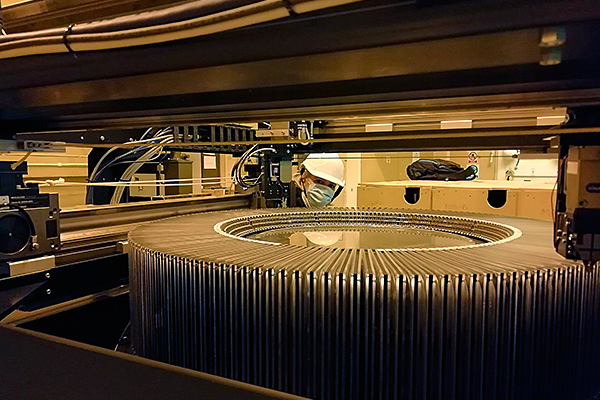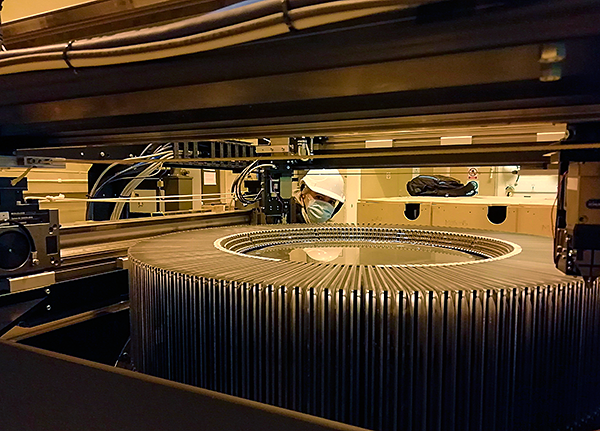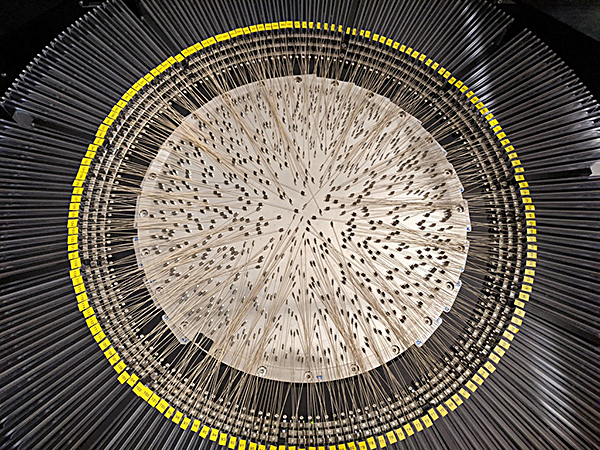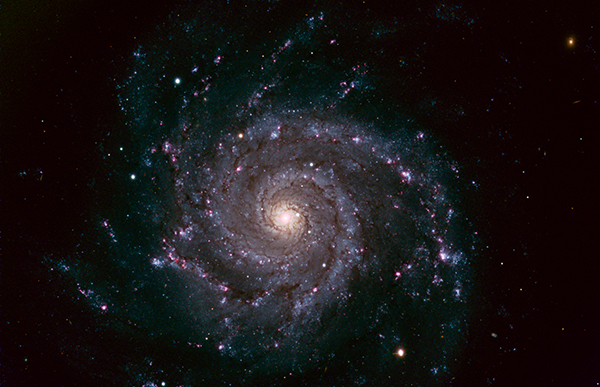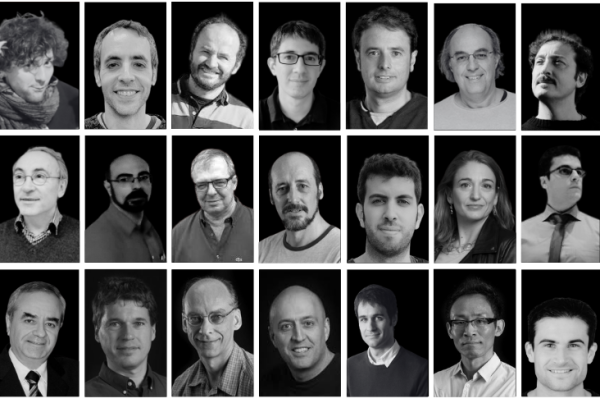The installation of the William Herschel Telescope Enhanced Area Velocity Explorer (WEAVE) at the William Herschel Telescope in La Palma (Canary Islands) is underway, so the WEAVE team is on the cusp of offering astronomers a new and improved eye on the stars.
For those who do not know, WEAVE is a multi-object survey wide-field spectrograph that will allow researchers to obtain the spectra of up to almost 1000 objects over a two-degree field of view in a single exposure. Its goals are to complement the major space- and ground-based programmes in the current and coming decade, including Gaia, LOFAR and Apertif, by providing a dedicated wide-field optical spectroscopic instrument in the Northern Hemisphere. It is being installed at the William Herschel Telescope (WHT), which is part of the Isaac Newton’s Group of Telescopes (ING) in La Palma, Canary Islands. Its fibre-fed spectrograph comprises two arms, one optimised for the blue side of the spectrum and one for the red side.
The main components of WEAVE are:
- The field Rotator, provided by the Instituto de Astrofísica de Canarias (IAC) in Spain and manufactured by IDOM (Spain).
- The prime-focus corrector, designed by ING, provided by the Instituto de Astrofísica de Canarias (IAC) in Spain with support from Konkoly Observatory (HU). Lenses were polished at KiwiStar in New Zealand, and co-mounted at SENER Aeroespacial (Spain).
- The fibre–positioner, developed by the University of Oxford and RAL Space in the UK, with support from the IAC.
- The fibres, provided by the Observatoire de Paris in France, manufactured in France, Canada and USA.
- The spectrograph, built by NOVA in the Netherlands with optical design by RAL Space in the UK, optics manufactured at INAOE (MX) and support from INAF (IT) and the IAC (ES).
- The CCD detectors system, provided by Liverpool John Moores University in the UK.
- The data processing, analysis and archiving, led by the University of Cambridge (UK) with support from the IAC (ES) and INAF (IT).
Following a year of installation of close to 100 km of optical fibre assemblies, WEAVE's fibre positioner has made the journey from the UK, and has now been tested and calibrated (its arrival and unpacking are documented in this photo sequence). The positioner is able to place full configurations of over 900 fibres in under one hour using its two high-speed industrial robots (video). Each fibre collects light from an individual object in the sky and feeds it around the telescope structure to the spectrograph. Thanks to the two different plates, one of them can be observing while the fibers are being positioned in the other one.
The instrument also allows for Integral Field Unit (IFU) observations with a large IFU mode covering 78 x 90 arcsec2 and a set of 20 miniIFU bundles of 11 x 12 arcsec2 each. Two different spectral resolutions will be available: a low resolution mode at R~5000 covering the spectral ranges 3660-6060 and 5790-9590 A, and a high resolution mode at R~20000 covering 4040-4650 and either 4730-5454 or 5950-6850 A.
|
WEAVE's fibre positioner after being unpacked at the WHT. In the centre of the image one of the MOS fibre plates can be seen, surrounded by three layers of parked fibre ends and, around these, the fin-like fibre-retractor boxes. Credit: Isaac Newton Group of Telescopes, La Palma. Large format: PNG. |
|
A fully-configured WEAVE field, with 700 of around 950 fibres placed by two robots (out of frame), on location in the WHT. Large format: JPG. Movies showing the two robots placing the fibres on plate: MP4 (1), MP4 (2). Credit: Gavin Dalton/U. Oxford and STFC's RAL Space. |
The installation of WEAVE marks a huge milestone in astronomy for several reasons. It will extend the telescope’s field of view to two degrees on the sky (or four times the apparent diameter of the moon), allowing it to capture the spectra of up to almost a thousand stars per hour. This will enable the detector to provide data from more than 12 million spectra, which will enhance the science return from Gaia, following up on Gaia’s sources and deepening the impact of both projects.
|
On-sky tests of the new prime-focus corrector (PFC) confirm that it delivers very sharp images, ensuring that in good seeing a given MOS fibre will collect 80% of the light, over a field of view 2 degrees, at all wavelengths from the ultra-violet to the far red. Following successful tests of the new PFC, and while integration of WEAVE proceeds at the WHT, one of the CMOS imagers used for the PFC tests has been offered to the community for science programmes. |
|
Image of M74 Galaxy obtained using PF-QHY on the WHT and R, G, B and Hα filters. Credit: Darío González Picos, Lara Monteagudo, Chris Benn and Ovidiu Vaduvescu. Large format: JPG. |
The on-sky commissioning of WEAVE will begin after integration of the instrument. In this phase, all the subsystems of the instrument are integrated together and tested as a system to verify that all the technical requirements are met. It will last 2 to 3 months and will be followed by science-verification (SV) observations. After SV, ING (Isaac Newton group of Telescopes) will commence routine survey and open-time observing. Regarding the latter, the first allocations, from the International Time Programme (ITP), have already been awarded, and an announcement of opportunity for open time will be issued once the commissioning of WEAVE is finished.
During the past few years, the WEAVE Science Team have been preparing the wide-ranging science plans that cover various fields of Galactic and extragalactic astronomy. There are currently eight independent WEAVE surveys planned, each with their own dedicated Science Teams, that will use up to 70% of the telescope’s allotted time during 5 years. WEAVE, with its MOS and IFU modes, will also be accessible to the wider astronomical community through open competition outside of this time. The planned WEAVE Surveys are the following:
- Galactic Archaeology (Team Lead: Vanessa Hill)
- Stellar, Circumstellar and Interstellar Physics (SCIP) (Team Lead: Janet Drew)
- Galaxy Clusters (Team Lead: J. Alfonso Lopez Aguerri)
- Stellar Populations at intermediate redshifts Survey (StePS) (Team Lead: Angela Iovino)
- WEAVE-Apertif (Team Lead: Jesús Falcón-Barroso)
- WEAVE-LOFAR (Team Lead: Dan Smith)
- WEAVE-QSO (Team Lead: Mat Pieri)
- WEAVE-WD (Team Lead: Boris Gaensicke)
WEAVE’s science team have all scientific programmes ready and they are preparing the observations for the eight surveys that will take place in the 5 years that the project is estimated to last. Several teams from the Institute of Cosmos Sciences of the University of Barcelona are involved in these surveys:
The Galactic Archaeology survey aims to complement the data obtained by Gaia by providing accurate radial velocities and elemental abundances for stars with V magnitude between 17 and 20 (for radial velocities) or between 12 and 17 (for elemental abundances). Some of its main science goals include: enabling the determination of fundamental Galactic parameters, investigating the origin of the thick stellar disk, identifying/characterising streams of stars in the Galaxy’s halo, studying the substructure in the disk kinematics, or characterising Open Clusters by studying their formation and evolution and using them as Galactic tracers. In this survey, we have members working specially on the Galactic disk component, such as Teresa Antoja -disk component leader-, Mercè Romero-Gómez -Survey Working Group member-, Francesca Figueras, Friedrich Anders, Eduard Masana, and in the Open Clusters component, such as Lola Balaguer-Núñez, Juan Carbajo-Hijarrubia, and Carme Jordi.
The SCIP-Stellar Circumstellar and Interstellar Physics survey will target the high-mass and young/old extremes of stellar evolution, along with the inter-stellar medium on the large scale, obtaining the spectra of objects such as OBA stars, Young Stellar Objects, Red Super Giants, Cepheids or stellar remnants and their ejecta. This will allow WEAVE to address questions regarding the relations between star formation, evolution, and the inter-stellar medium seen in both emission and absorption, as well as Galactic disk structure as seen through the young component. This survey counts with the participation of researcher Maria Monguió (Survey Woking Group member) and Francesca Figueras.
The WEAVE-QSO survey will collect observations from the Lyman-alpha forest – a ‘forest’ of absorption lines seen along the lined of sight to distant Quasi-Stellar-Objects (QSOs) that are caused by the intervening intergalactic medium (IGM) and circumgalactic medium (CGM). The WEAVE-QSOs survey will provide IGM/CGM temperature, density, 3-D mapping and clustering. Clustering information includes the measurement of Baryonic Acoustic Oscillations, a 'standard ruler' enabling to probe the accelerating expansion of the Universe and thus gain a better understanding of 'dark energy'. They will tackle questions such as ‘How did the accelerated expansion of the universe emerge?’ This survey counts with the participation of researcher Jordi Miralda.
